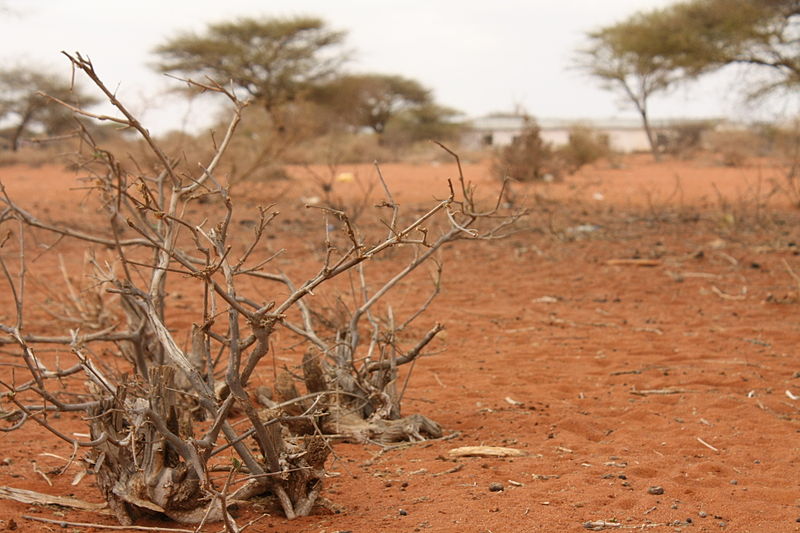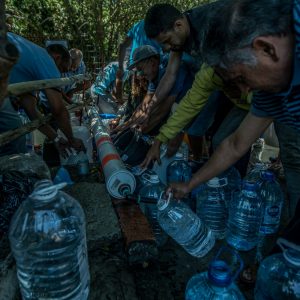Drought has left millions in the region facing food insecurity—and conditions are expected to get worse.

The landscape of Kulaley Village in northern Kenya lays barren after a drought in 2011. Photo © OxFam East Africa / Wikimedia Commons.
- Climate models indicate the potential for another brutal famine in East Africa.
- As dry conditions bear on, humanitarian groups are calling on the international community to take action before it is too late.
- Drought, which used to occur once or twice in a decade, now happens every two or three years in the region. Scientists say the pattern is yet another effect of global climate change.
By Laura Gersony, Circle of Blue — October 18, 2021
In 2011, two failed rainy seasons thrust the Horn of Africa into the worst famine of the twenty-first century. An estimated 260,000 Somalis died of starvation, over half of them children. Antelope carcasses dotted the savanna. As crops withered, about half of the region’s livestock, whose milk millions of children relied on for nutrition, perished.
Such terrible outcomes could again be on the horizon. Climate models indicate the potential for another brutal famine in East Africa. As dry conditions bear on, humanitarian groups are calling on the international community to take action before it is too late.
As of early September, over 29 million people were already experiencing food insecurity in the region, about 500,000 of which were in the worst category of “catastrophic,” meaning severe malnutrition and starvation. If the coming months bring another dry season—an outcome which all global and regional services are projecting—millions more will be pushed into hunger.
“In the absence of immediate action, the magnitude of food insecurity and malnutrition across Ethiopia, Kenya, and Somalia will likely grow,” according to an alert from the Food Security and Nutrition Working Group.
East Africa typically experiences two rainy seasons: one from October to December, and another from March to May. Last year, both of these seasons came in below average. Chris Funk, the director of UC Santa Barbara’s Climate Hazards Center, wrote in The Conversation that the upcoming season is projected to be similarly dry.
“We now think that a devastating drought is likely to happen again, in 2021/2022,” Funk wrote. Drought leads to famine only when support networks fail to respond.
The purpose of the forecasting efforts is to support that response: “without effective early action, all the data collection and modelling is of limited value, and people end up suffering,” Funk added.
Another poor rainy season would be nothing short of cataclysmic. The Kenyan government’s recent Long Rains Report found that production of maize, the country’s staple food, is projected to decline by 50 percent in the affected regions. Some areas are expected to face total crop failure. This would not only endanger agricultural communities, but also poor urban residents, for whom skyrocketing food prices could spell doom.
Last century, droughts would occur every five or six years. Now, Funk wrote, it happens every two or three years—a cumulative strain on the region already weakened by civil strife, poverty, and, this year, locusts.
“You have two seasons of depressed rains, desert locusts ravaging farmlands in the same counties and people fighting over the few resources available. That is the making of a disaster,” Asha Mohammed, secretary general of the Kenya Red Cross, told The Guardian.
Scientists say the pattern is yet another effect of global climate change. The La Niña weather pattern, driven by normal cooling cycles in the eastern Pacific, has always caused dry spells in East Africa. But as global greenhouse gas emissions rapidly warm the western Pacific Ocean, the La Niña is becoming more frequent and severe.
Humanitarian organizations are urging the international community to send aid to the region. Proposed solutions include conducting animal health treatment campaigns, sending financial support to vulnerable farmers, distributing drought-tolerant seeds, and more.
Laura Gersony covers water policy, infrastructure, and energy for Circle of Blue. She also writes FRESH, Circle of Blue’s biweekly digest of Great Lakes policy news, and HotSpots H2O, a monthly column about the regions and populations most at-risk for water-related hazards and conflict. She is an Environmental Studies and Political Science major at the University of Chicago and an avid Lake Michigan swimmer.




